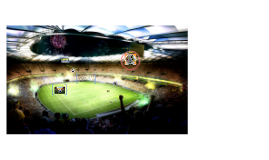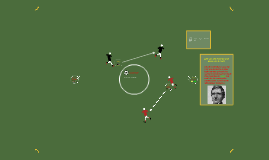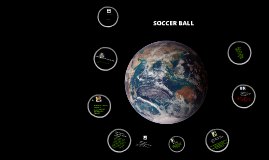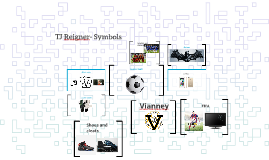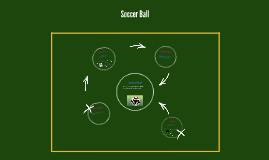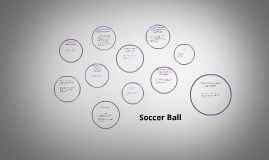Soccer Ball
Transcript: A video was created on testing the goal line technology (GLT system), it shows that every time the "whole" ball crosses the goal, an indication on the referee's watch appears. Formation Players such as Manchester United's Cristiano Ronaldo has perfected a way to kick the soccer ball where it barely spins on its axis. This means that as air rushes over the joints of the ball, it creates turbulence that can suddenly change the ball's movement at any time while still in the air. History Modern soccer balls use a combination of synthetic leather and polystyrene foam, which improved their touch, acceleration, and velocity. Major soccer ball manufacturers are continuing to experiment with their designs in an effort to improve goal-scoring and offensive strategies. The first collected evidence of an early form of a soccer ball dates back to about 3,000 years ago in Ancient China The game was named "tsu chu" (or "cuju"), by 50AD. The ancient Greeks, Romans, and even Egyptians are recorded to have enjoyed a similar game that involved a makeshift ball similar to the soccer ball. The last time a leather ball was used was in the 1982 World Cup in Spain. Shortly after, the ball was named the Adidas' Tango Espana. Advancements Soccer Ball Little Big History Project By: Nachelle Horne In 1855, Charles Goodyear created the first vulcanized rubber soccer ball. This soccer ball served its first game on November 7, 1863. During this time, the modern style of the soccer ball was first developed. Prior to the 1970s, there was another development in soccer ball design - The Buckminster Ball. The ball had been made of a tanned leather cover with eighteen sections stitched together, arranged in six panels of three strips each. Instead of panels, hexagons were stitched together. This design became a very popular design that is still utilized by modern soccer ball manufacturers. Technology, Math, and Sports Science were and still are used in the creation of this ball. Math is used for calculations when forming the ball. Sports Science is used for history and ideas for improvements of the soccer ball. Soccer balls have been apart/included in thresholds as well. Thresholds such as 1) Collective Learning, 2) The Big Bang, 3) Chemical Elements, and 4) The Modern Revolution. New balls and technologies are being developed to help the game and referees on knowing the true outcome of the game. By using a magnetic field and more stabilized and robust components within the ball, the new system is more precise rather than the previously tested which used radio transmissions. Synthetic Soccer Balls The modern soccer ball has highly evolved in terms of materials and designs. Other than that, the ball specifications have not changed much over the decades. The modern soccer ball is lighter, non-absorbent, more durable, and provides better game-play through hi-tech design. The object is to develop the optimum soccer ball that is flight accurate, water proof, fast in flight, can transfer all kicking force, has a soft foot, can bounce predictability, and is safe for a header. The look of the ball is also important among consumers. The material, the stitching, the dimensions, and the kick of the ball determines winners and losers. The soccer ball really makes a difference in a soccer game. The Buckminster Ball Older balls had a problem with water absorption. By coating the soccer ball with synthetic and non-porous materials, balls absorb less water. Early footballs were sewn up with laces. A valve is the part where an air pump is attached to inflate the ball with air. A new valve replaced the laced slit on the sides of the soccer ball. The 1960s saw the introduction of synthetic soccer balls. These balls were designed with synthetic leather, but they did not replace leather balls until the 1980s. Synthetic balls are generally softer and more responsive than others. Specific Requirements http://www.soccerballworld.com/History.htm#Early http://www.life123.com/sports/soccer/soccer-equipment/soccer-ball-history.shtml http://ipl.org/div/farq/soccerFARQ.html http://alanmichelen.wordpress.com/2013/05/03/modern-day-soccer-balls/ http://paulkho.weebly.com/soccer-balls.html http://www.sportinglife360.com/index.php/history-of-the-soccer-ball-3-5232/ http://gotham-magazine.com/home-page/articles/uncharted-plays-energy-producing-soccer-balls The Azteca by Adidas was the first synthetic ball used in a FIFA World Cup. This ball was the first polyurethane coated ball that is rain-resistant. FIFA (International Federation of Association Football) also set requirements of the ball. Some requirements being, 1) The ball must have a circumference of 68-70 centimeters, 2) The weight of the ball must be between 410-450 grams, 3) It must be inflated to a pressure of 8-12 PSI (pound square inch), and 4) The ball must be covered with leather or "other suitable material." As of now, the standard size of the soccer ball is size 5. There are smaller sizes but they are used for






